Opinion of Probation Officers on Restorative Justice
VerifiedAdded on 2023/03/24
|15
|4768
|76
AI Summary
This dissertation explores the opinion of probation officers in London towards the government's initiative to increase the use of restorative justice in probation practice. It examines the effectiveness of restorative justice in reducing adult offender rates and promoting community safety. The study aims to understand the concept of restorative justice, evaluate the role of probation services, and identify the beliefs of probation officers towards restorative justice. The findings will provide recommendations for the government to enhance the use of restorative justice in probation practice.
Contribute Materials
Your contribution can guide someone’s learning journey. Share your
documents today.
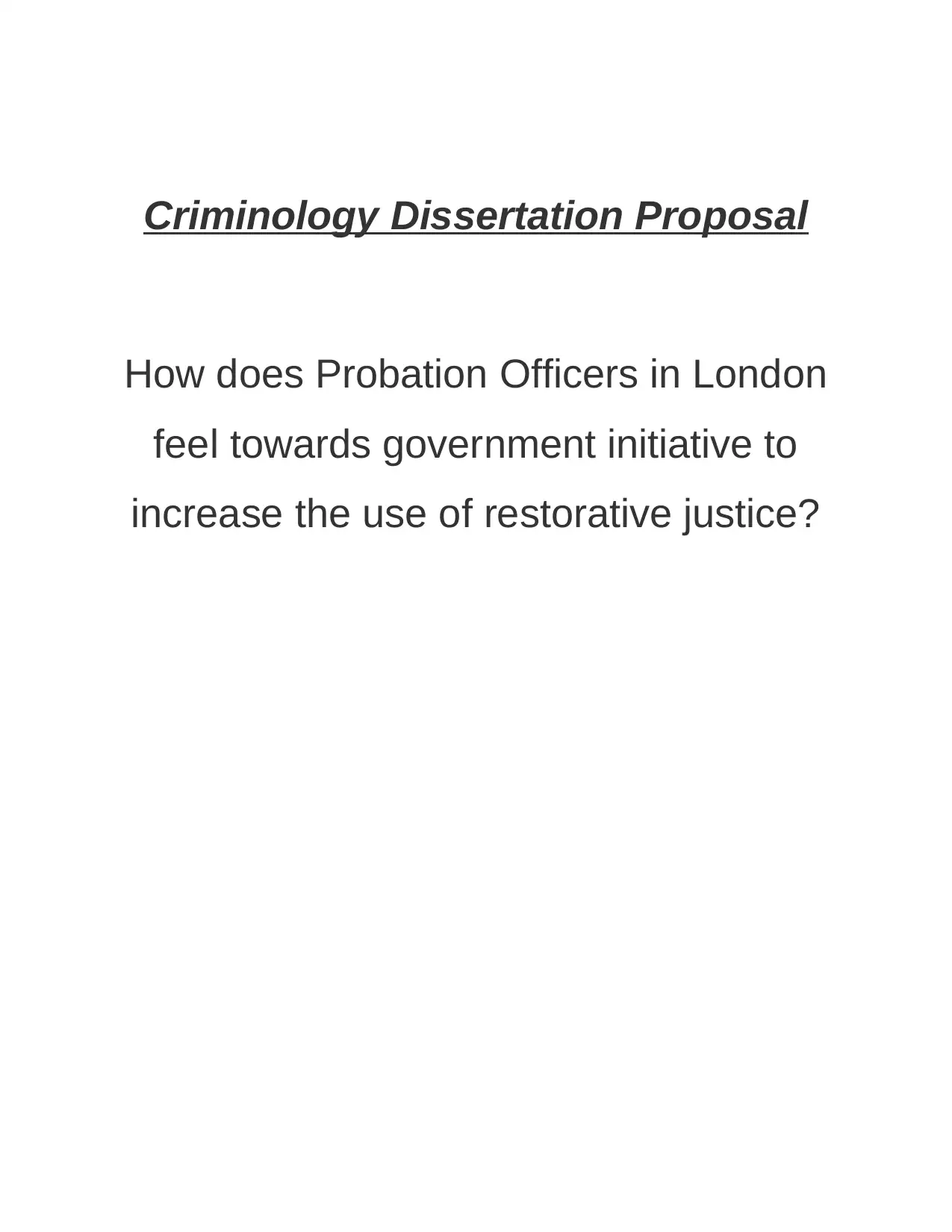
Criminology Dissertation Proposal
How does Probation Officers in London
feel towards government initiative to
increase the use of restorative justice?
How does Probation Officers in London
feel towards government initiative to
increase the use of restorative justice?
Secure Best Marks with AI Grader
Need help grading? Try our AI Grader for instant feedback on your assignments.

Table of Contents
CHAPTER 1: INTRODUCTION ........................................................................................3
1.1 Overview of the research.........................................................................................3
1.2 Aims and objectives ................................................................................................4
1.3 Chapter Structure of the dissertation:......................................................................4
1.4 Purpose of study......................................................................................................5
CHAPTER 2: LITERATURE REVIEW ..............................................................................7
2.1 Introduction..............................................................................................................7
2.2 The concept of restorative justice in probation practice. .......................................7
CHAPTER 3: RESEARCH METHODOLOGY.................................................................10
Research approach: ...................................................................................................10
Research design:.........................................................................................................10
Data collection.............................................................................................................10
CHAPTER 1: INTRODUCTION ........................................................................................3
1.1 Overview of the research.........................................................................................3
1.2 Aims and objectives ................................................................................................4
1.3 Chapter Structure of the dissertation:......................................................................4
1.4 Purpose of study......................................................................................................5
CHAPTER 2: LITERATURE REVIEW ..............................................................................7
2.1 Introduction..............................................................................................................7
2.2 The concept of restorative justice in probation practice. .......................................7
CHAPTER 3: RESEARCH METHODOLOGY.................................................................10
Research approach: ...................................................................................................10
Research design:.........................................................................................................10
Data collection.............................................................................................................10
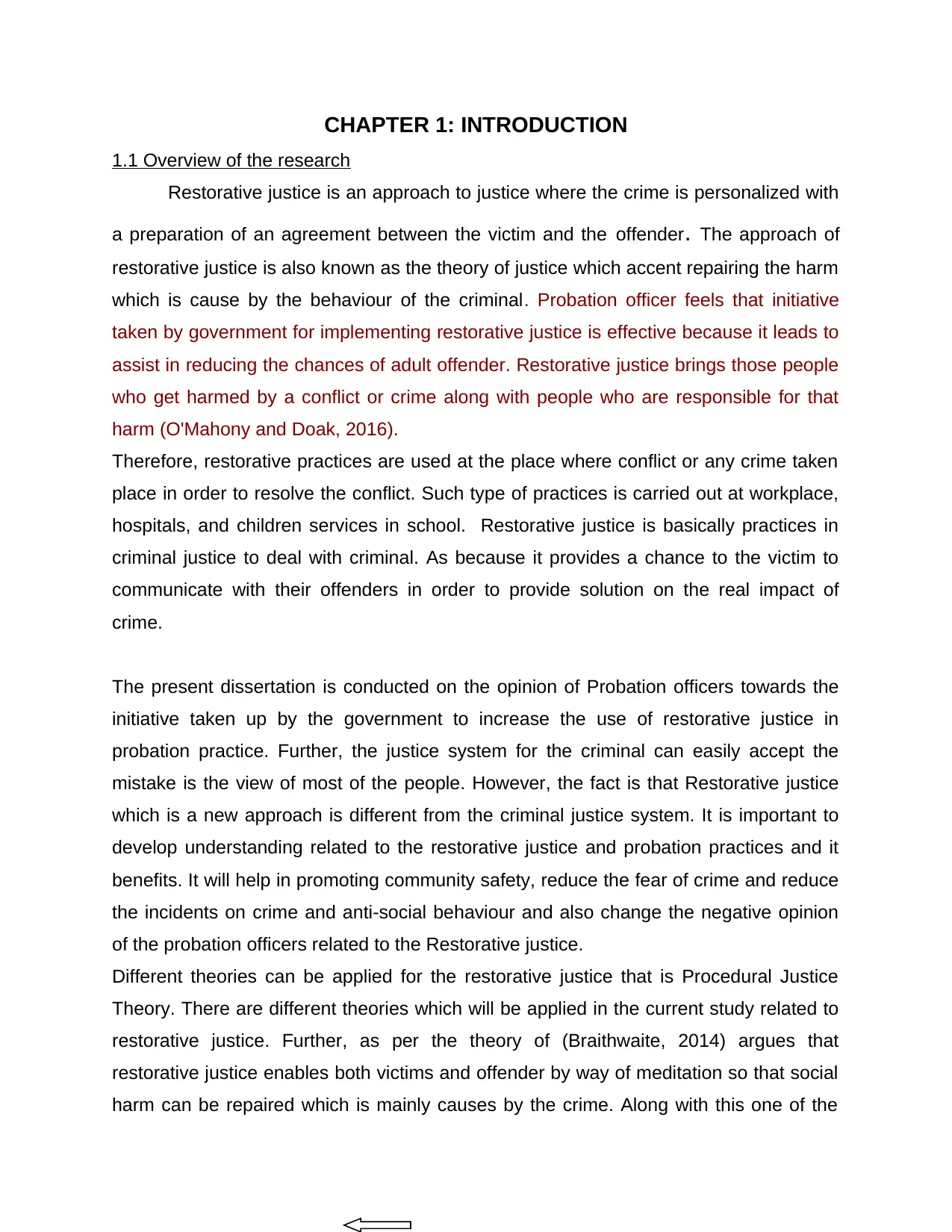
CHAPTER 1: INTRODUCTION
1.1 Overview of the research
Restorative justice is an approach to justice where the crime is personalized with
a preparation of an agreement between the victim and the offender. The approach of
restorative justice is also known as the theory of justice which accent repairing the harm
which is cause by the behaviour of the criminal. Probation officer feels that initiative
taken by government for implementing restorative justice is effective because it leads to
assist in reducing the chances of adult offender. Restorative justice brings those people
who get harmed by a conflict or crime along with people who are responsible for that
harm (O'Mahony and Doak, 2016).
Therefore, restorative practices are used at the place where conflict or any crime taken
place in order to resolve the conflict. Such type of practices is carried out at workplace,
hospitals, and children services in school. Restorative justice is basically practices in
criminal justice to deal with criminal. As because it provides a chance to the victim to
communicate with their offenders in order to provide solution on the real impact of
crime.
The present dissertation is conducted on the opinion of Probation officers towards the
initiative taken up by the government to increase the use of restorative justice in
probation practice. Further, the justice system for the criminal can easily accept the
mistake is the view of most of the people. However, the fact is that Restorative justice
which is a new approach is different from the criminal justice system. It is important to
develop understanding related to the restorative justice and probation practices and it
benefits. It will help in promoting community safety, reduce the fear of crime and reduce
the incidents on crime and anti-social behaviour and also change the negative opinion
of the probation officers related to the Restorative justice.
Different theories can be applied for the restorative justice that is Procedural Justice
Theory. There are different theories which will be applied in the current study related to
restorative justice. Further, as per the theory of (Braithwaite, 2014) argues that
restorative justice enables both victims and offender by way of meditation so that social
harm can be repaired which is mainly causes by the crime. Along with this one of the
1.1 Overview of the research
Restorative justice is an approach to justice where the crime is personalized with
a preparation of an agreement between the victim and the offender. The approach of
restorative justice is also known as the theory of justice which accent repairing the harm
which is cause by the behaviour of the criminal. Probation officer feels that initiative
taken by government for implementing restorative justice is effective because it leads to
assist in reducing the chances of adult offender. Restorative justice brings those people
who get harmed by a conflict or crime along with people who are responsible for that
harm (O'Mahony and Doak, 2016).
Therefore, restorative practices are used at the place where conflict or any crime taken
place in order to resolve the conflict. Such type of practices is carried out at workplace,
hospitals, and children services in school. Restorative justice is basically practices in
criminal justice to deal with criminal. As because it provides a chance to the victim to
communicate with their offenders in order to provide solution on the real impact of
crime.
The present dissertation is conducted on the opinion of Probation officers towards the
initiative taken up by the government to increase the use of restorative justice in
probation practice. Further, the justice system for the criminal can easily accept the
mistake is the view of most of the people. However, the fact is that Restorative justice
which is a new approach is different from the criminal justice system. It is important to
develop understanding related to the restorative justice and probation practices and it
benefits. It will help in promoting community safety, reduce the fear of crime and reduce
the incidents on crime and anti-social behaviour and also change the negative opinion
of the probation officers related to the Restorative justice.
Different theories can be applied for the restorative justice that is Procedural Justice
Theory. There are different theories which will be applied in the current study related to
restorative justice. Further, as per the theory of (Braithwaite, 2014) argues that
restorative justice enables both victims and offender by way of meditation so that social
harm can be repaired which is mainly causes by the crime. Along with this one of the
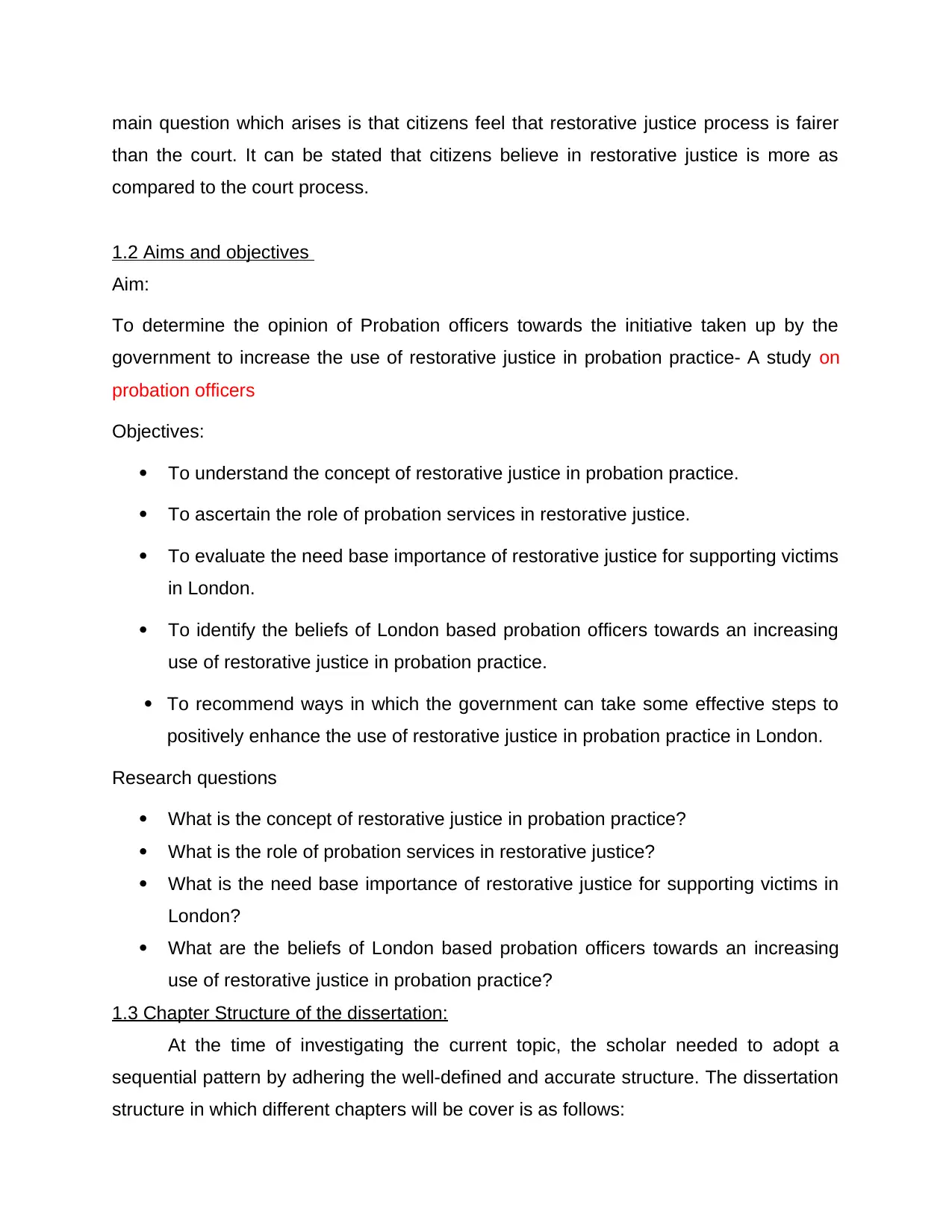
main question which arises is that citizens feel that restorative justice process is fairer
than the court. It can be stated that citizens believe in restorative justice is more as
compared to the court process.
1.2 Aims and objectives
Aim:
To determine the opinion of Probation officers towards the initiative taken up by the
government to increase the use of restorative justice in probation practice- A study on
probation officers
Objectives:
To understand the concept of restorative justice in probation practice.
To ascertain the role of probation services in restorative justice.
To evaluate the need base importance of restorative justice for supporting victims
in London.
To identify the beliefs of London based probation officers towards an increasing
use of restorative justice in probation practice.
To recommend ways in which the government can take some effective steps to
positively enhance the use of restorative justice in probation practice in London.
Research questions
What is the concept of restorative justice in probation practice?
What is the role of probation services in restorative justice?
What is the need base importance of restorative justice for supporting victims in
London?
What are the beliefs of London based probation officers towards an increasing
use of restorative justice in probation practice?
1.3 Chapter Structure of the dissertation:
At the time of investigating the current topic, the scholar needed to adopt a
sequential pattern by adhering the well-defined and accurate structure. The dissertation
structure in which different chapters will be cover is as follows:
than the court. It can be stated that citizens believe in restorative justice is more as
compared to the court process.
1.2 Aims and objectives
Aim:
To determine the opinion of Probation officers towards the initiative taken up by the
government to increase the use of restorative justice in probation practice- A study on
probation officers
Objectives:
To understand the concept of restorative justice in probation practice.
To ascertain the role of probation services in restorative justice.
To evaluate the need base importance of restorative justice for supporting victims
in London.
To identify the beliefs of London based probation officers towards an increasing
use of restorative justice in probation practice.
To recommend ways in which the government can take some effective steps to
positively enhance the use of restorative justice in probation practice in London.
Research questions
What is the concept of restorative justice in probation practice?
What is the role of probation services in restorative justice?
What is the need base importance of restorative justice for supporting victims in
London?
What are the beliefs of London based probation officers towards an increasing
use of restorative justice in probation practice?
1.3 Chapter Structure of the dissertation:
At the time of investigating the current topic, the scholar needed to adopt a
sequential pattern by adhering the well-defined and accurate structure. The dissertation
structure in which different chapters will be cover is as follows:
Secure Best Marks with AI Grader
Need help grading? Try our AI Grader for instant feedback on your assignments.

Chapter 1: Introduction – In this chapter detail information will be provided related
to the topic which is selected for the research. It includes an overview of the
study and importance of restorative justice. At the end of this chapter importance
of the research topic and research tools and techniques will be discussed
Chapter 2: Literature Review – In the second section the understanding will be
developed related to the concept of restorative justice. Further the need base
importance of restorative justice for supporting victims in London. Will need to be
evaluated. At last, the beliefs of London based probation officers towards an
increasing use of restorative justice in probation practice will be identified.
Chapter 3: Research Methodology – Different tools and techniques which will be
used for the present research will be discussed. Along with this, validation of the
methods which will be used is provided. Further, this chapter will cover limitation
and ethical consideration and resources which are used by the researcher.
Chapter 4: Data Analysis and Findings – All the gathered information will be
analysed in section 4.
Chapter 5: Conclusion and Recommendations – Conclusion will be provided in
this chapter on the basis of collected data. Further, suggestion will be given.
1.4 Purpose of study
The purpose of this study is to investigate the opinion of Probation officers
towards the initiative taken up by the government to increase the use of restorative
justice in probation practice. Restorative justice practices are effective in order to reduce
the number of crimes from the city. Restorative justice provides chance to both offender
and victim to communicate relating to the harm caused and take out the solution for
repairing the harm. However, communication takes place at the time when offender
accept its crime and ready to apologise or pay for the causes of harm to victim.
Further, it needs to make sure that the process of communication will be safe and
further no harm will be caused to the victim. Further, it is identified that sometimes face
to face meeting is not the right way to deal, so the facilitator will arrange interview or
letter for communication. Restorative justice is effective and it can be used at any
criminal stage and in any type of crime. The present dissertation aid in developing deep
understanding related to the restorative justice and probation practices and it benefits.
to the topic which is selected for the research. It includes an overview of the
study and importance of restorative justice. At the end of this chapter importance
of the research topic and research tools and techniques will be discussed
Chapter 2: Literature Review – In the second section the understanding will be
developed related to the concept of restorative justice. Further the need base
importance of restorative justice for supporting victims in London. Will need to be
evaluated. At last, the beliefs of London based probation officers towards an
increasing use of restorative justice in probation practice will be identified.
Chapter 3: Research Methodology – Different tools and techniques which will be
used for the present research will be discussed. Along with this, validation of the
methods which will be used is provided. Further, this chapter will cover limitation
and ethical consideration and resources which are used by the researcher.
Chapter 4: Data Analysis and Findings – All the gathered information will be
analysed in section 4.
Chapter 5: Conclusion and Recommendations – Conclusion will be provided in
this chapter on the basis of collected data. Further, suggestion will be given.
1.4 Purpose of study
The purpose of this study is to investigate the opinion of Probation officers
towards the initiative taken up by the government to increase the use of restorative
justice in probation practice. Restorative justice practices are effective in order to reduce
the number of crimes from the city. Restorative justice provides chance to both offender
and victim to communicate relating to the harm caused and take out the solution for
repairing the harm. However, communication takes place at the time when offender
accept its crime and ready to apologise or pay for the causes of harm to victim.
Further, it needs to make sure that the process of communication will be safe and
further no harm will be caused to the victim. Further, it is identified that sometimes face
to face meeting is not the right way to deal, so the facilitator will arrange interview or
letter for communication. Restorative justice is effective and it can be used at any
criminal stage and in any type of crime. The present dissertation aid in developing deep
understanding related to the restorative justice and probation practices and it benefits.
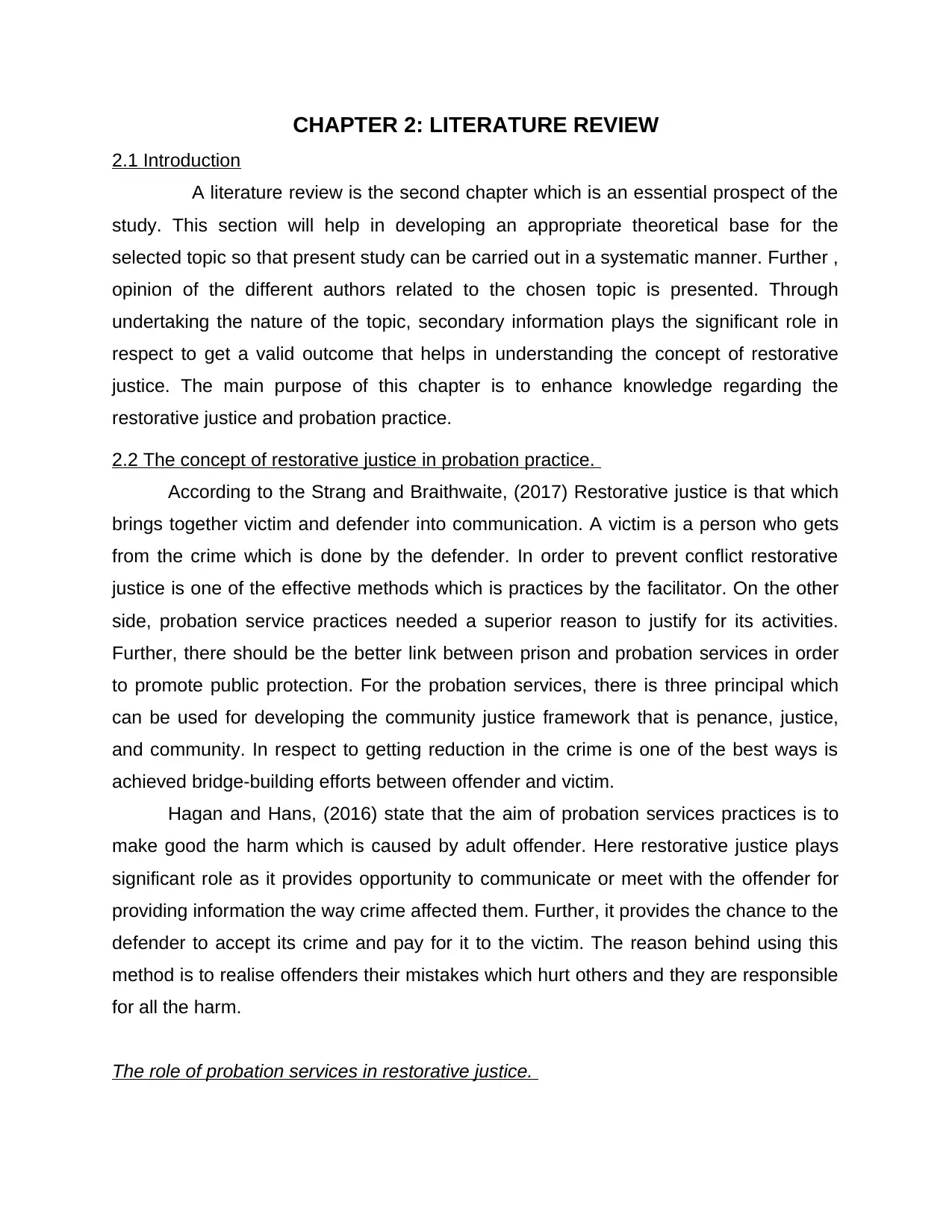
CHAPTER 2: LITERATURE REVIEW
2.1 Introduction
A literature review is the second chapter which is an essential prospect of the
study. This section will help in developing an appropriate theoretical base for the
selected topic so that present study can be carried out in a systematic manner. Further ,
opinion of the different authors related to the chosen topic is presented. Through
undertaking the nature of the topic, secondary information plays the significant role in
respect to get a valid outcome that helps in understanding the concept of restorative
justice. The main purpose of this chapter is to enhance knowledge regarding the
restorative justice and probation practice.
2.2 The concept of restorative justice in probation practice.
According to the Strang and Braithwaite, (2017) Restorative justice is that which
brings together victim and defender into communication. A victim is a person who gets
from the crime which is done by the defender. In order to prevent conflict restorative
justice is one of the effective methods which is practices by the facilitator. On the other
side, probation service practices needed a superior reason to justify for its activities.
Further, there should be the better link between prison and probation services in order
to promote public protection. For the probation services, there is three principal which
can be used for developing the community justice framework that is penance, justice,
and community. In respect to getting reduction in the crime is one of the best ways is
achieved bridge-building efforts between offender and victim.
Hagan and Hans, (2016) state that the aim of probation services practices is to
make good the harm which is caused by adult offender. Here restorative justice plays
significant role as it provides opportunity to communicate or meet with the offender for
providing information the way crime affected them. Further, it provides the chance to the
defender to accept its crime and pay for it to the victim. The reason behind using this
method is to realise offenders their mistakes which hurt others and they are responsible
for all the harm.
The role of probation services in restorative justice.
2.1 Introduction
A literature review is the second chapter which is an essential prospect of the
study. This section will help in developing an appropriate theoretical base for the
selected topic so that present study can be carried out in a systematic manner. Further ,
opinion of the different authors related to the chosen topic is presented. Through
undertaking the nature of the topic, secondary information plays the significant role in
respect to get a valid outcome that helps in understanding the concept of restorative
justice. The main purpose of this chapter is to enhance knowledge regarding the
restorative justice and probation practice.
2.2 The concept of restorative justice in probation practice.
According to the Strang and Braithwaite, (2017) Restorative justice is that which
brings together victim and defender into communication. A victim is a person who gets
from the crime which is done by the defender. In order to prevent conflict restorative
justice is one of the effective methods which is practices by the facilitator. On the other
side, probation service practices needed a superior reason to justify for its activities.
Further, there should be the better link between prison and probation services in order
to promote public protection. For the probation services, there is three principal which
can be used for developing the community justice framework that is penance, justice,
and community. In respect to getting reduction in the crime is one of the best ways is
achieved bridge-building efforts between offender and victim.
Hagan and Hans, (2016) state that the aim of probation services practices is to
make good the harm which is caused by adult offender. Here restorative justice plays
significant role as it provides opportunity to communicate or meet with the offender for
providing information the way crime affected them. Further, it provides the chance to the
defender to accept its crime and pay for it to the victim. The reason behind using this
method is to realise offenders their mistakes which hurt others and they are responsible
for all the harm.
The role of probation services in restorative justice.
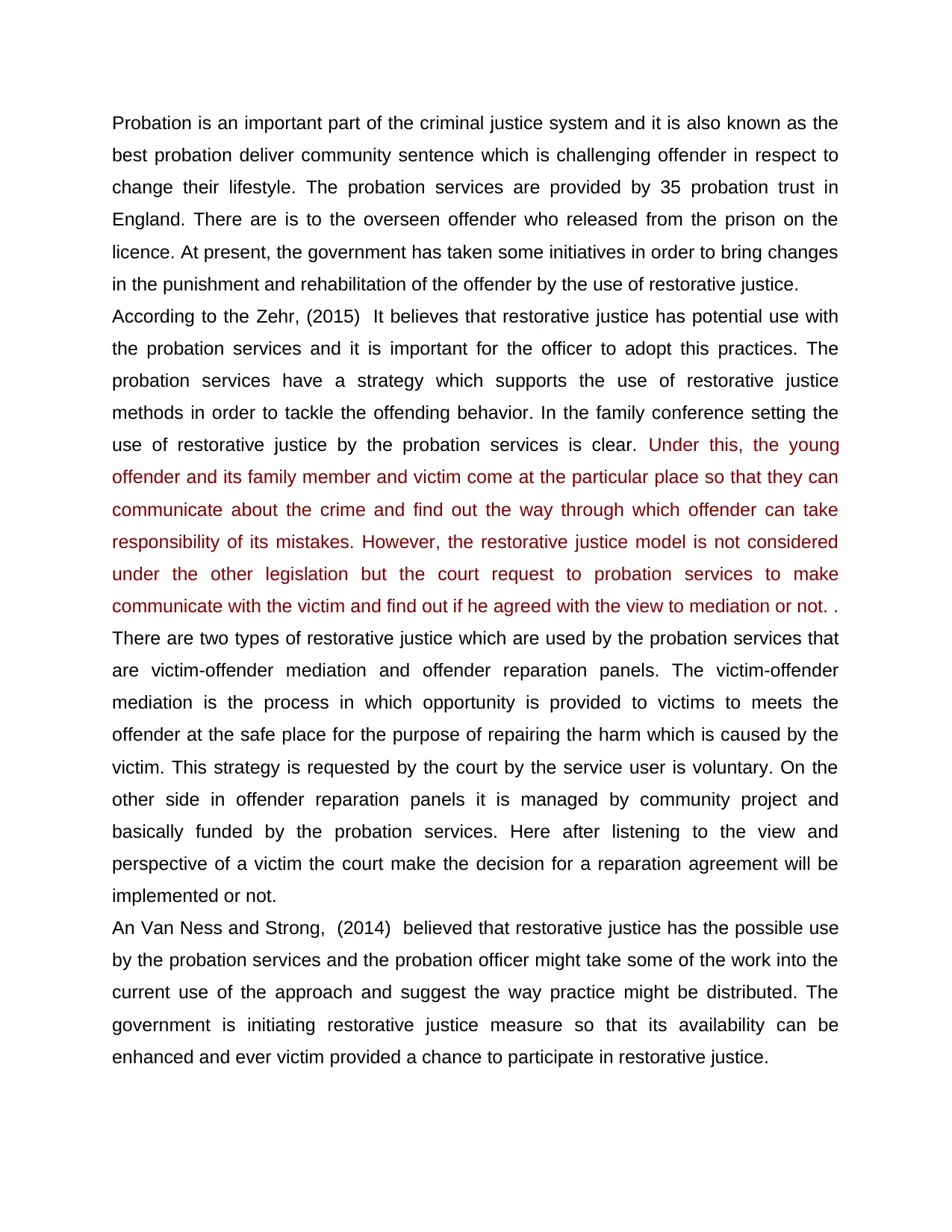
Probation is an important part of the criminal justice system and it is also known as the
best probation deliver community sentence which is challenging offender in respect to
change their lifestyle. The probation services are provided by 35 probation trust in
England. There are is to the overseen offender who released from the prison on the
licence. At present, the government has taken some initiatives in order to bring changes
in the punishment and rehabilitation of the offender by the use of restorative justice.
According to the Zehr, (2015) It believes that restorative justice has potential use with
the probation services and it is important for the officer to adopt this practices. The
probation services have a strategy which supports the use of restorative justice
methods in order to tackle the offending behavior. In the family conference setting the
use of restorative justice by the probation services is clear. Under this, the young
offender and its family member and victim come at the particular place so that they can
communicate about the crime and find out the way through which offender can take
responsibility of its mistakes. However, the restorative justice model is not considered
under the other legislation but the court request to probation services to make
communicate with the victim and find out if he agreed with the view to mediation or not. .
There are two types of restorative justice which are used by the probation services that
are victim-offender mediation and offender reparation panels. The victim-offender
mediation is the process in which opportunity is provided to victims to meets the
offender at the safe place for the purpose of repairing the harm which is caused by the
victim. This strategy is requested by the court by the service user is voluntary. On the
other side in offender reparation panels it is managed by community project and
basically funded by the probation services. Here after listening to the view and
perspective of a victim the court make the decision for a reparation agreement will be
implemented or not.
An Van Ness and Strong, (2014) believed that restorative justice has the possible use
by the probation services and the probation officer might take some of the work into the
current use of the approach and suggest the way practice might be distributed. The
government is initiating restorative justice measure so that its availability can be
enhanced and ever victim provided a chance to participate in restorative justice.
best probation deliver community sentence which is challenging offender in respect to
change their lifestyle. The probation services are provided by 35 probation trust in
England. There are is to the overseen offender who released from the prison on the
licence. At present, the government has taken some initiatives in order to bring changes
in the punishment and rehabilitation of the offender by the use of restorative justice.
According to the Zehr, (2015) It believes that restorative justice has potential use with
the probation services and it is important for the officer to adopt this practices. The
probation services have a strategy which supports the use of restorative justice
methods in order to tackle the offending behavior. In the family conference setting the
use of restorative justice by the probation services is clear. Under this, the young
offender and its family member and victim come at the particular place so that they can
communicate about the crime and find out the way through which offender can take
responsibility of its mistakes. However, the restorative justice model is not considered
under the other legislation but the court request to probation services to make
communicate with the victim and find out if he agreed with the view to mediation or not. .
There are two types of restorative justice which are used by the probation services that
are victim-offender mediation and offender reparation panels. The victim-offender
mediation is the process in which opportunity is provided to victims to meets the
offender at the safe place for the purpose of repairing the harm which is caused by the
victim. This strategy is requested by the court by the service user is voluntary. On the
other side in offender reparation panels it is managed by community project and
basically funded by the probation services. Here after listening to the view and
perspective of a victim the court make the decision for a reparation agreement will be
implemented or not.
An Van Ness and Strong, (2014) believed that restorative justice has the possible use
by the probation services and the probation officer might take some of the work into the
current use of the approach and suggest the way practice might be distributed. The
government is initiating restorative justice measure so that its availability can be
enhanced and ever victim provided a chance to participate in restorative justice.
Paraphrase This Document
Need a fresh take? Get an instant paraphrase of this document with our AI Paraphraser
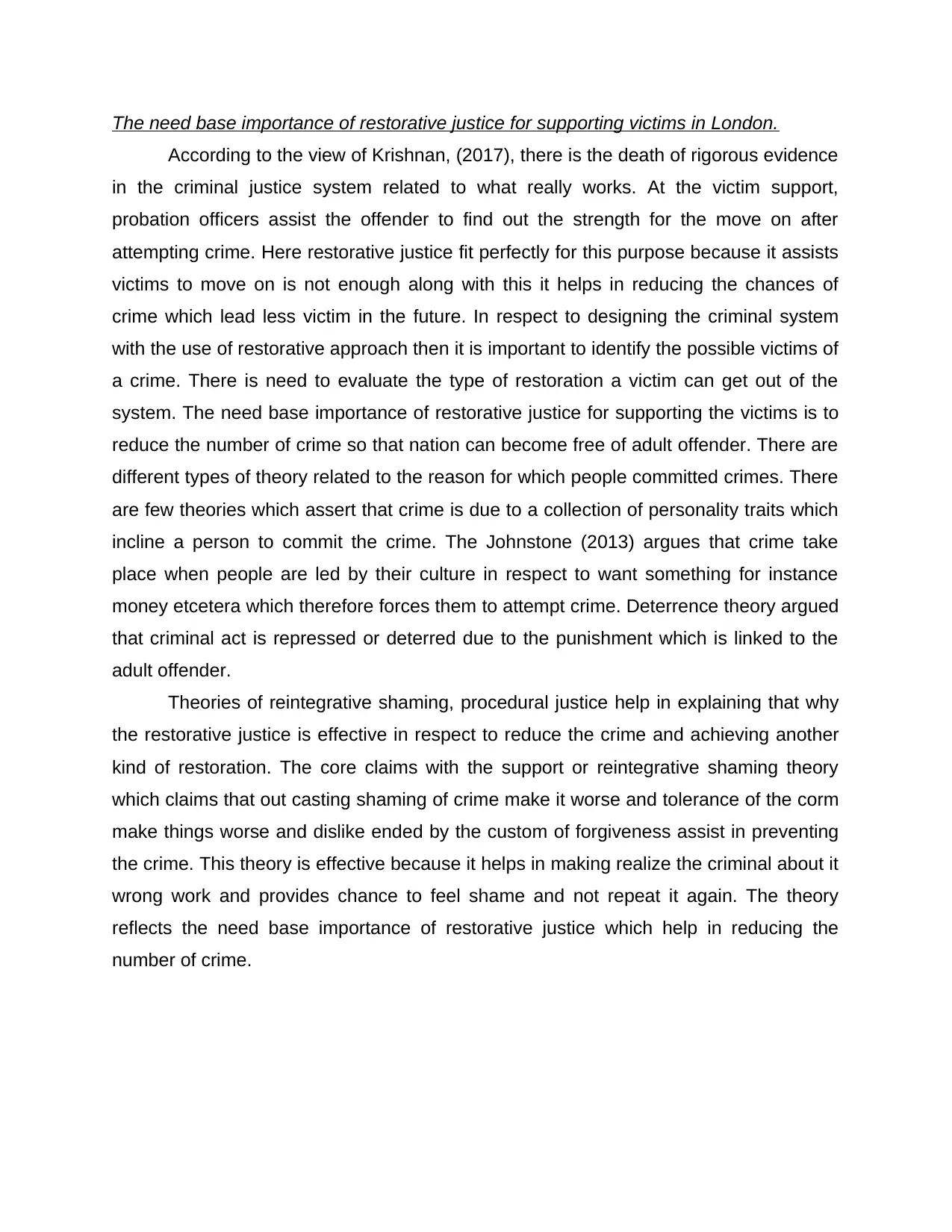
The need base importance of restorative justice for supporting victims in London.
According to the view of Krishnan, (2017), there is the death of rigorous evidence
in the criminal justice system related to what really works. At the victim support,
probation officers assist the offender to find out the strength for the move on after
attempting crime. Here restorative justice fit perfectly for this purpose because it assists
victims to move on is not enough along with this it helps in reducing the chances of
crime which lead less victim in the future. In respect to designing the criminal system
with the use of restorative approach then it is important to identify the possible victims of
a crime. There is need to evaluate the type of restoration a victim can get out of the
system. The need base importance of restorative justice for supporting the victims is to
reduce the number of crime so that nation can become free of adult offender. There are
different types of theory related to the reason for which people committed crimes. There
are few theories which assert that crime is due to a collection of personality traits which
incline a person to commit the crime. The Johnstone (2013) argues that crime take
place when people are led by their culture in respect to want something for instance
money etcetera which therefore forces them to attempt crime. Deterrence theory argued
that criminal act is repressed or deterred due to the punishment which is linked to the
adult offender.
Theories of reintegrative shaming, procedural justice help in explaining that why
the restorative justice is effective in respect to reduce the crime and achieving another
kind of restoration. The core claims with the support or reintegrative shaming theory
which claims that out casting shaming of crime make it worse and tolerance of the corm
make things worse and dislike ended by the custom of forgiveness assist in preventing
the crime. This theory is effective because it helps in making realize the criminal about it
wrong work and provides chance to feel shame and not repeat it again. The theory
reflects the need base importance of restorative justice which help in reducing the
number of crime.
According to the view of Krishnan, (2017), there is the death of rigorous evidence
in the criminal justice system related to what really works. At the victim support,
probation officers assist the offender to find out the strength for the move on after
attempting crime. Here restorative justice fit perfectly for this purpose because it assists
victims to move on is not enough along with this it helps in reducing the chances of
crime which lead less victim in the future. In respect to designing the criminal system
with the use of restorative approach then it is important to identify the possible victims of
a crime. There is need to evaluate the type of restoration a victim can get out of the
system. The need base importance of restorative justice for supporting the victims is to
reduce the number of crime so that nation can become free of adult offender. There are
different types of theory related to the reason for which people committed crimes. There
are few theories which assert that crime is due to a collection of personality traits which
incline a person to commit the crime. The Johnstone (2013) argues that crime take
place when people are led by their culture in respect to want something for instance
money etcetera which therefore forces them to attempt crime. Deterrence theory argued
that criminal act is repressed or deterred due to the punishment which is linked to the
adult offender.
Theories of reintegrative shaming, procedural justice help in explaining that why
the restorative justice is effective in respect to reduce the crime and achieving another
kind of restoration. The core claims with the support or reintegrative shaming theory
which claims that out casting shaming of crime make it worse and tolerance of the corm
make things worse and dislike ended by the custom of forgiveness assist in preventing
the crime. This theory is effective because it helps in making realize the criminal about it
wrong work and provides chance to feel shame and not repeat it again. The theory
reflects the need base importance of restorative justice which help in reducing the
number of crime.
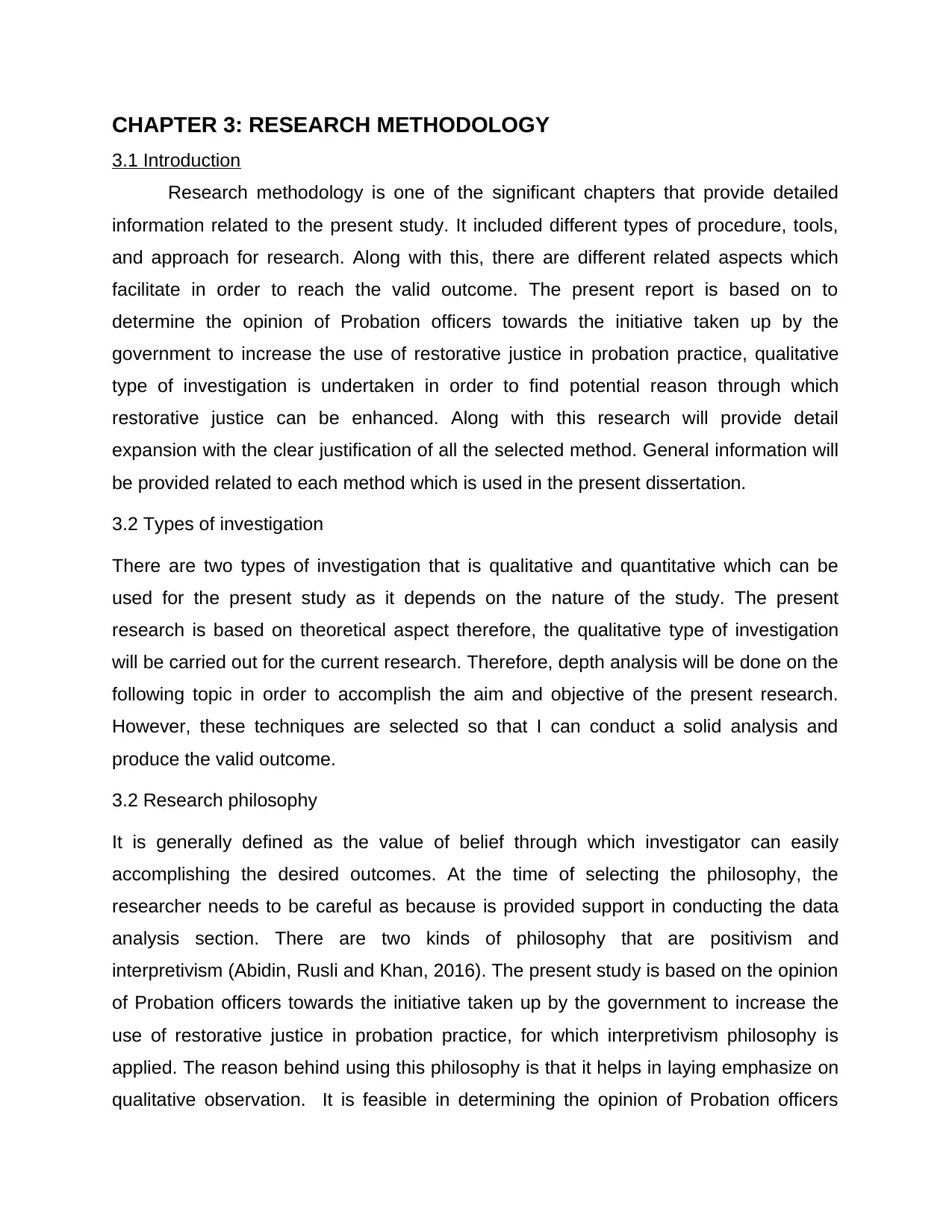
CHAPTER 3: RESEARCH METHODOLOGY
3.1 Introduction
Research methodology is one of the significant chapters that provide detailed
information related to the present study. It included different types of procedure, tools,
and approach for research. Along with this, there are different related aspects which
facilitate in order to reach the valid outcome. The present report is based on to
determine the opinion of Probation officers towards the initiative taken up by the
government to increase the use of restorative justice in probation practice, qualitative
type of investigation is undertaken in order to find potential reason through which
restorative justice can be enhanced. Along with this research will provide detail
expansion with the clear justification of all the selected method. General information will
be provided related to each method which is used in the present dissertation.
3.2 Types of investigation
There are two types of investigation that is qualitative and quantitative which can be
used for the present study as it depends on the nature of the study. The present
research is based on theoretical aspect therefore, the qualitative type of investigation
will be carried out for the current research. Therefore, depth analysis will be done on the
following topic in order to accomplish the aim and objective of the present research.
However, these techniques are selected so that I can conduct a solid analysis and
produce the valid outcome.
3.2 Research philosophy
It is generally defined as the value of belief through which investigator can easily
accomplishing the desired outcomes. At the time of selecting the philosophy, the
researcher needs to be careful as because is provided support in conducting the data
analysis section. There are two kinds of philosophy that are positivism and
interpretivism (Abidin, Rusli and Khan, 2016). The present study is based on the opinion
of Probation officers towards the initiative taken up by the government to increase the
use of restorative justice in probation practice, for which interpretivism philosophy is
applied. The reason behind using this philosophy is that it helps in laying emphasize on
qualitative observation. It is feasible in determining the opinion of Probation officers
3.1 Introduction
Research methodology is one of the significant chapters that provide detailed
information related to the present study. It included different types of procedure, tools,
and approach for research. Along with this, there are different related aspects which
facilitate in order to reach the valid outcome. The present report is based on to
determine the opinion of Probation officers towards the initiative taken up by the
government to increase the use of restorative justice in probation practice, qualitative
type of investigation is undertaken in order to find potential reason through which
restorative justice can be enhanced. Along with this research will provide detail
expansion with the clear justification of all the selected method. General information will
be provided related to each method which is used in the present dissertation.
3.2 Types of investigation
There are two types of investigation that is qualitative and quantitative which can be
used for the present study as it depends on the nature of the study. The present
research is based on theoretical aspect therefore, the qualitative type of investigation
will be carried out for the current research. Therefore, depth analysis will be done on the
following topic in order to accomplish the aim and objective of the present research.
However, these techniques are selected so that I can conduct a solid analysis and
produce the valid outcome.
3.2 Research philosophy
It is generally defined as the value of belief through which investigator can easily
accomplishing the desired outcomes. At the time of selecting the philosophy, the
researcher needs to be careful as because is provided support in conducting the data
analysis section. There are two kinds of philosophy that are positivism and
interpretivism (Abidin, Rusli and Khan, 2016). The present study is based on the opinion
of Probation officers towards the initiative taken up by the government to increase the
use of restorative justice in probation practice, for which interpretivism philosophy is
applied. The reason behind using this philosophy is that it helps in laying emphasize on
qualitative observation. It is feasible in determining the opinion of Probation officers

towards the initiative taken up by the government to increase the use of restorative
justice in probation practice.
Research approach:
The research approach is known as the way of conducting the study in a
systematic manner. There is two important type of approaches that is deductive and
inductive. Further inductive approach focus on moving from general to specific while
deductive use for specific to general information (Kalra, Phadnis and Joshi, 2017. For
the present dissertation, the researcher will use inductive approach as because it is
appropriate for the qualitative investigation. Along with this it also provides the better
outcome for the selected topic that is the opinion of Probation officers towards the
initiative taken up by the government to increase the use of restorative justice in
probation practice. The reason behind using the inductive approach is to first select the
general information than focus on specific issues which are identified related to the
selected topic. Along with this it also permits a researcher to develop understanding
related to the Restorative justice and then find the main causes behind carrying out this
lead to create.
Research design:
The research design is essential elements of research methodology it is so
because the design of the research is defined as a blueprint of study which assists in
developing a base. Along with this, it can be stated that it provides detail outline of the
study which provides detail information regarding the way through which researcher is
accented to continue the entire study. There are the different type of research design
which can be used for the present research that is descriptive, explanatory and
exploratory research design (Landau, Mitnik and Lev-Ari, 2016.). The exploratory
research design focus on uncovering the issues which are not identified yet. On the
other side descriptive focus on explaining the selected topic in a theoretical manner.
Looking at the nature of the selected topic descriptive research design has been
undertaken. The reason behind selecting this technique is that it will help scholar to
justice in probation practice.
Research approach:
The research approach is known as the way of conducting the study in a
systematic manner. There is two important type of approaches that is deductive and
inductive. Further inductive approach focus on moving from general to specific while
deductive use for specific to general information (Kalra, Phadnis and Joshi, 2017. For
the present dissertation, the researcher will use inductive approach as because it is
appropriate for the qualitative investigation. Along with this it also provides the better
outcome for the selected topic that is the opinion of Probation officers towards the
initiative taken up by the government to increase the use of restorative justice in
probation practice. The reason behind using the inductive approach is to first select the
general information than focus on specific issues which are identified related to the
selected topic. Along with this it also permits a researcher to develop understanding
related to the Restorative justice and then find the main causes behind carrying out this
lead to create.
Research design:
The research design is essential elements of research methodology it is so
because the design of the research is defined as a blueprint of study which assists in
developing a base. Along with this, it can be stated that it provides detail outline of the
study which provides detail information regarding the way through which researcher is
accented to continue the entire study. There are the different type of research design
which can be used for the present research that is descriptive, explanatory and
exploratory research design (Landau, Mitnik and Lev-Ari, 2016.). The exploratory
research design focus on uncovering the issues which are not identified yet. On the
other side descriptive focus on explaining the selected topic in a theoretical manner.
Looking at the nature of the selected topic descriptive research design has been
undertaken. The reason behind selecting this technique is that it will help scholar to
Secure Best Marks with AI Grader
Need help grading? Try our AI Grader for instant feedback on your assignments.
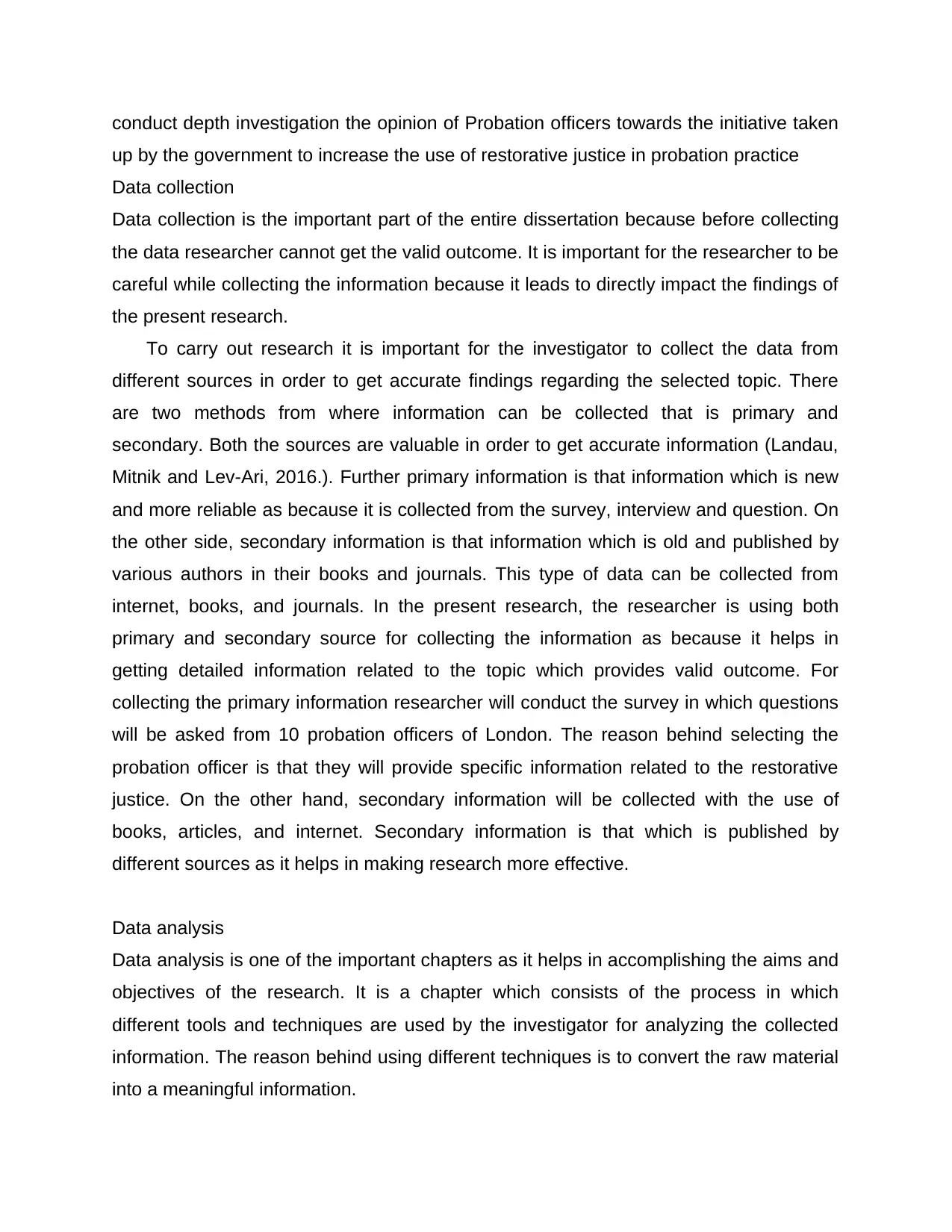
conduct depth investigation the opinion of Probation officers towards the initiative taken
up by the government to increase the use of restorative justice in probation practice
Data collection
Data collection is the important part of the entire dissertation because before collecting
the data researcher cannot get the valid outcome. It is important for the researcher to be
careful while collecting the information because it leads to directly impact the findings of
the present research.
To carry out research it is important for the investigator to collect the data from
different sources in order to get accurate findings regarding the selected topic. There
are two methods from where information can be collected that is primary and
secondary. Both the sources are valuable in order to get accurate information (Landau,
Mitnik and Lev-Ari, 2016.). Further primary information is that information which is new
and more reliable as because it is collected from the survey, interview and question. On
the other side, secondary information is that information which is old and published by
various authors in their books and journals. This type of data can be collected from
internet, books, and journals. In the present research, the researcher is using both
primary and secondary source for collecting the information as because it helps in
getting detailed information related to the topic which provides valid outcome. For
collecting the primary information researcher will conduct the survey in which questions
will be asked from 10 probation officers of London. The reason behind selecting the
probation officer is that they will provide specific information related to the restorative
justice. On the other hand, secondary information will be collected with the use of
books, articles, and internet. Secondary information is that which is published by
different sources as it helps in making research more effective.
Data analysis
Data analysis is one of the important chapters as it helps in accomplishing the aims and
objectives of the research. It is a chapter which consists of the process in which
different tools and techniques are used by the investigator for analyzing the collected
information. The reason behind using different techniques is to convert the raw material
into a meaningful information.
up by the government to increase the use of restorative justice in probation practice
Data collection
Data collection is the important part of the entire dissertation because before collecting
the data researcher cannot get the valid outcome. It is important for the researcher to be
careful while collecting the information because it leads to directly impact the findings of
the present research.
To carry out research it is important for the investigator to collect the data from
different sources in order to get accurate findings regarding the selected topic. There
are two methods from where information can be collected that is primary and
secondary. Both the sources are valuable in order to get accurate information (Landau,
Mitnik and Lev-Ari, 2016.). Further primary information is that information which is new
and more reliable as because it is collected from the survey, interview and question. On
the other side, secondary information is that information which is old and published by
various authors in their books and journals. This type of data can be collected from
internet, books, and journals. In the present research, the researcher is using both
primary and secondary source for collecting the information as because it helps in
getting detailed information related to the topic which provides valid outcome. For
collecting the primary information researcher will conduct the survey in which questions
will be asked from 10 probation officers of London. The reason behind selecting the
probation officer is that they will provide specific information related to the restorative
justice. On the other hand, secondary information will be collected with the use of
books, articles, and internet. Secondary information is that which is published by
different sources as it helps in making research more effective.
Data analysis
Data analysis is one of the important chapters as it helps in accomplishing the aims and
objectives of the research. It is a chapter which consists of the process in which
different tools and techniques are used by the investigator for analyzing the collected
information. The reason behind using different techniques is to convert the raw material
into a meaningful information.
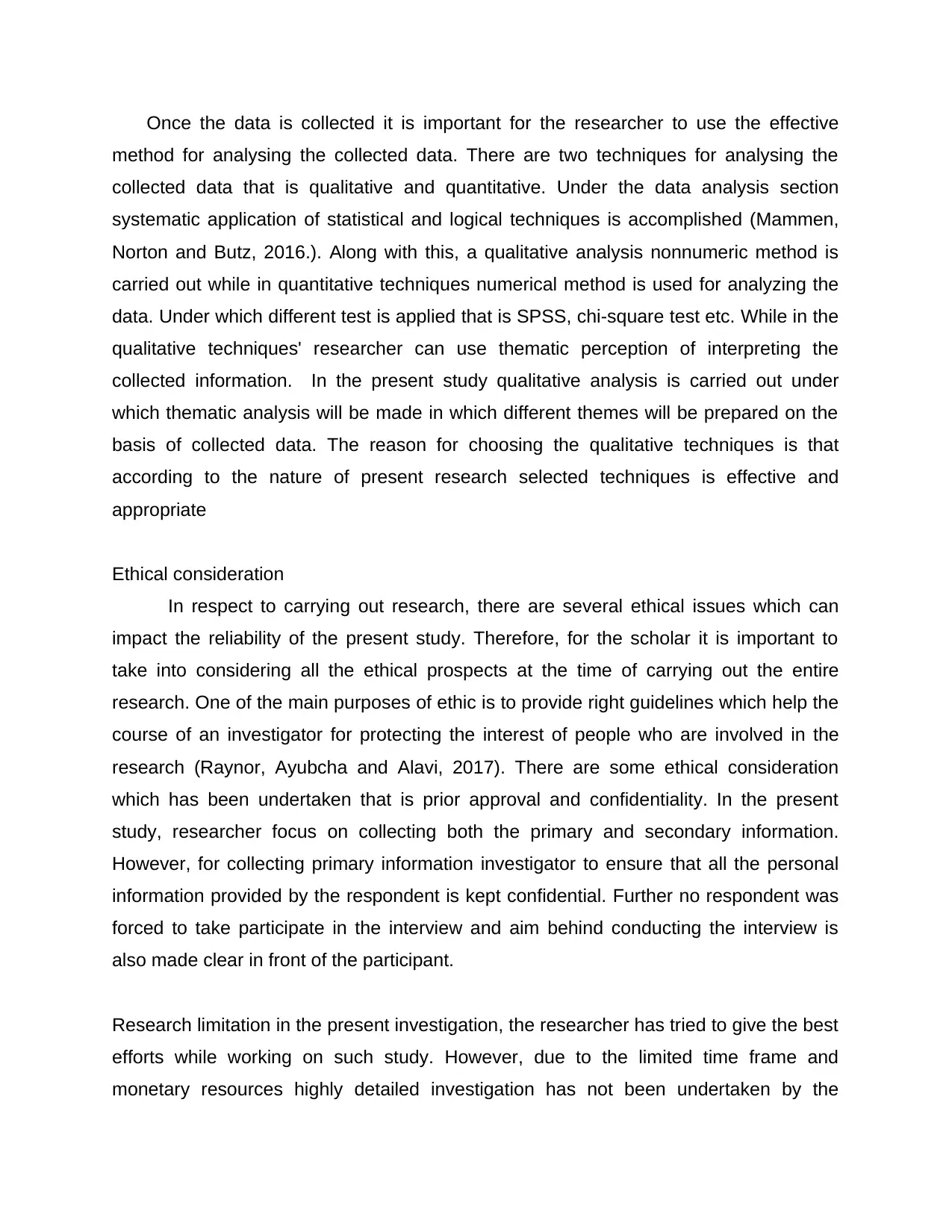
Once the data is collected it is important for the researcher to use the effective
method for analysing the collected data. There are two techniques for analysing the
collected data that is qualitative and quantitative. Under the data analysis section
systematic application of statistical and logical techniques is accomplished (Mammen,
Norton and Butz, 2016.). Along with this, a qualitative analysis nonnumeric method is
carried out while in quantitative techniques numerical method is used for analyzing the
data. Under which different test is applied that is SPSS, chi-square test etc. While in the
qualitative techniques' researcher can use thematic perception of interpreting the
collected information. In the present study qualitative analysis is carried out under
which thematic analysis will be made in which different themes will be prepared on the
basis of collected data. The reason for choosing the qualitative techniques is that
according to the nature of present research selected techniques is effective and
appropriate
Ethical consideration
In respect to carrying out research, there are several ethical issues which can
impact the reliability of the present study. Therefore, for the scholar it is important to
take into considering all the ethical prospects at the time of carrying out the entire
research. One of the main purposes of ethic is to provide right guidelines which help the
course of an investigator for protecting the interest of people who are involved in the
research (Raynor, Ayubcha and Alavi, 2017). There are some ethical consideration
which has been undertaken that is prior approval and confidentiality. In the present
study, researcher focus on collecting both the primary and secondary information.
However, for collecting primary information investigator to ensure that all the personal
information provided by the respondent is kept confidential. Further no respondent was
forced to take participate in the interview and aim behind conducting the interview is
also made clear in front of the participant.
Research limitation in the present investigation, the researcher has tried to give the best
efforts while working on such study. However, due to the limited time frame and
monetary resources highly detailed investigation has not been undertaken by the
method for analysing the collected data. There are two techniques for analysing the
collected data that is qualitative and quantitative. Under the data analysis section
systematic application of statistical and logical techniques is accomplished (Mammen,
Norton and Butz, 2016.). Along with this, a qualitative analysis nonnumeric method is
carried out while in quantitative techniques numerical method is used for analyzing the
data. Under which different test is applied that is SPSS, chi-square test etc. While in the
qualitative techniques' researcher can use thematic perception of interpreting the
collected information. In the present study qualitative analysis is carried out under
which thematic analysis will be made in which different themes will be prepared on the
basis of collected data. The reason for choosing the qualitative techniques is that
according to the nature of present research selected techniques is effective and
appropriate
Ethical consideration
In respect to carrying out research, there are several ethical issues which can
impact the reliability of the present study. Therefore, for the scholar it is important to
take into considering all the ethical prospects at the time of carrying out the entire
research. One of the main purposes of ethic is to provide right guidelines which help the
course of an investigator for protecting the interest of people who are involved in the
research (Raynor, Ayubcha and Alavi, 2017). There are some ethical consideration
which has been undertaken that is prior approval and confidentiality. In the present
study, researcher focus on collecting both the primary and secondary information.
However, for collecting primary information investigator to ensure that all the personal
information provided by the respondent is kept confidential. Further no respondent was
forced to take participate in the interview and aim behind conducting the interview is
also made clear in front of the participant.
Research limitation in the present investigation, the researcher has tried to give the best
efforts while working on such study. However, due to the limited time frame and
monetary resources highly detailed investigation has not been undertaken by the
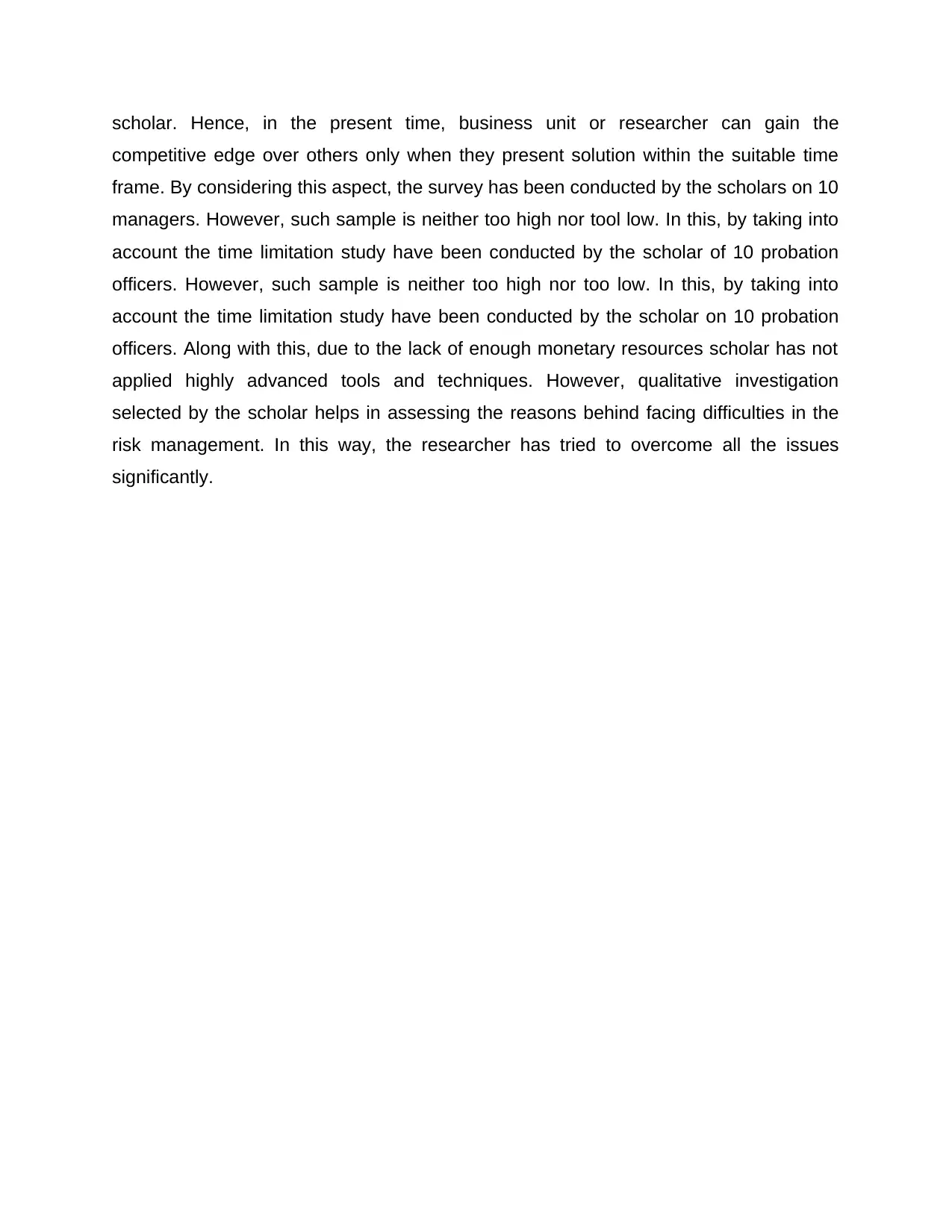
scholar. Hence, in the present time, business unit or researcher can gain the
competitive edge over others only when they present solution within the suitable time
frame. By considering this aspect, the survey has been conducted by the scholars on 10
managers. However, such sample is neither too high nor tool low. In this, by taking into
account the time limitation study have been conducted by the scholar of 10 probation
officers. However, such sample is neither too high nor too low. In this, by taking into
account the time limitation study have been conducted by the scholar on 10 probation
officers. Along with this, due to the lack of enough monetary resources scholar has not
applied highly advanced tools and techniques. However, qualitative investigation
selected by the scholar helps in assessing the reasons behind facing difficulties in the
risk management. In this way, the researcher has tried to overcome all the issues
significantly.
competitive edge over others only when they present solution within the suitable time
frame. By considering this aspect, the survey has been conducted by the scholars on 10
managers. However, such sample is neither too high nor tool low. In this, by taking into
account the time limitation study have been conducted by the scholar of 10 probation
officers. However, such sample is neither too high nor too low. In this, by taking into
account the time limitation study have been conducted by the scholar on 10 probation
officers. Along with this, due to the lack of enough monetary resources scholar has not
applied highly advanced tools and techniques. However, qualitative investigation
selected by the scholar helps in assessing the reasons behind facing difficulties in the
risk management. In this way, the researcher has tried to overcome all the issues
significantly.
Paraphrase This Document
Need a fresh take? Get an instant paraphrase of this document with our AI Paraphraser
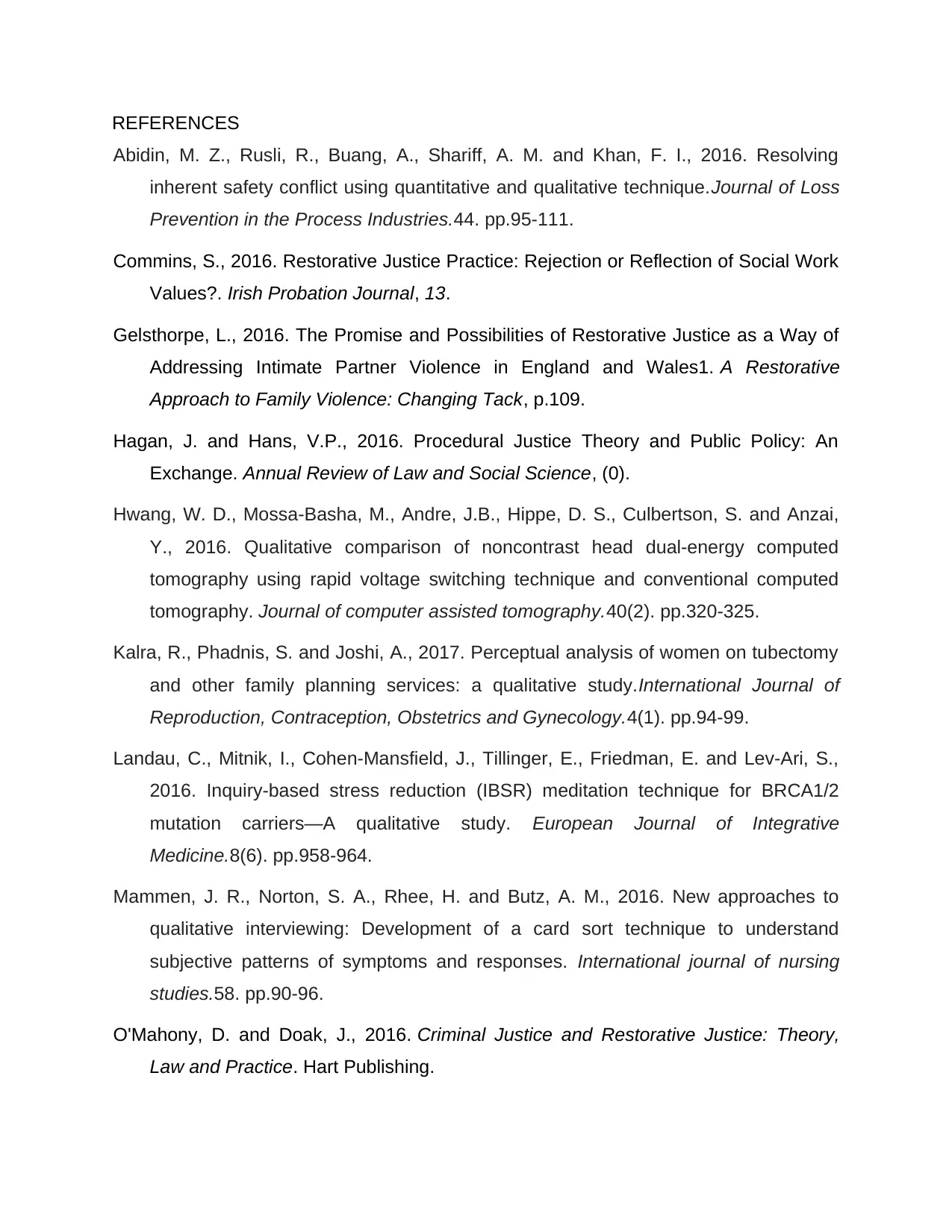
REFERENCES
Abidin, M. Z., Rusli, R., Buang, A., Shariff, A. M. and Khan, F. I., 2016. Resolving
inherent safety conflict using quantitative and qualitative technique.Journal of Loss
Prevention in the Process Industries.44. pp.95-111.
Commins, S., 2016. Restorative Justice Practice: Rejection or Reflection of Social Work
Values?. Irish Probation Journal, 13.
Gelsthorpe, L., 2016. The Promise and Possibilities of Restorative Justice as a Way of
Addressing Intimate Partner Violence in England and Wales1. A Restorative
Approach to Family Violence: Changing Tack, p.109.
Hagan, J. and Hans, V.P., 2016. Procedural Justice Theory and Public Policy: An
Exchange. Annual Review of Law and Social Science, (0).
Hwang, W. D., Mossa-Basha, M., Andre, J.B., Hippe, D. S., Culbertson, S. and Anzai,
Y., 2016. Qualitative comparison of noncontrast head dual-energy computed
tomography using rapid voltage switching technique and conventional computed
tomography. Journal of computer assisted tomography.40(2). pp.320-325.
Kalra, R., Phadnis, S. and Joshi, A., 2017. Perceptual analysis of women on tubectomy
and other family planning services: a qualitative study.International Journal of
Reproduction, Contraception, Obstetrics and Gynecology.4(1). pp.94-99.
Landau, C., Mitnik, I., Cohen-Mansfield, J., Tillinger, E., Friedman, E. and Lev-Ari, S.,
2016. Inquiry-based stress reduction (IBSR) meditation technique for BRCA1/2
mutation carriers—A qualitative study. European Journal of Integrative
Medicine.8(6). pp.958-964.
Mammen, J. R., Norton, S. A., Rhee, H. and Butz, A. M., 2016. New approaches to
qualitative interviewing: Development of a card sort technique to understand
subjective patterns of symptoms and responses. International journal of nursing
studies.58. pp.90-96.
O'Mahony, D. and Doak, J., 2016. Criminal Justice and Restorative Justice: Theory,
Law and Practice. Hart Publishing.
Abidin, M. Z., Rusli, R., Buang, A., Shariff, A. M. and Khan, F. I., 2016. Resolving
inherent safety conflict using quantitative and qualitative technique.Journal of Loss
Prevention in the Process Industries.44. pp.95-111.
Commins, S., 2016. Restorative Justice Practice: Rejection or Reflection of Social Work
Values?. Irish Probation Journal, 13.
Gelsthorpe, L., 2016. The Promise and Possibilities of Restorative Justice as a Way of
Addressing Intimate Partner Violence in England and Wales1. A Restorative
Approach to Family Violence: Changing Tack, p.109.
Hagan, J. and Hans, V.P., 2016. Procedural Justice Theory and Public Policy: An
Exchange. Annual Review of Law and Social Science, (0).
Hwang, W. D., Mossa-Basha, M., Andre, J.B., Hippe, D. S., Culbertson, S. and Anzai,
Y., 2016. Qualitative comparison of noncontrast head dual-energy computed
tomography using rapid voltage switching technique and conventional computed
tomography. Journal of computer assisted tomography.40(2). pp.320-325.
Kalra, R., Phadnis, S. and Joshi, A., 2017. Perceptual analysis of women on tubectomy
and other family planning services: a qualitative study.International Journal of
Reproduction, Contraception, Obstetrics and Gynecology.4(1). pp.94-99.
Landau, C., Mitnik, I., Cohen-Mansfield, J., Tillinger, E., Friedman, E. and Lev-Ari, S.,
2016. Inquiry-based stress reduction (IBSR) meditation technique for BRCA1/2
mutation carriers—A qualitative study. European Journal of Integrative
Medicine.8(6). pp.958-964.
Mammen, J. R., Norton, S. A., Rhee, H. and Butz, A. M., 2016. New approaches to
qualitative interviewing: Development of a card sort technique to understand
subjective patterns of symptoms and responses. International journal of nursing
studies.58. pp.90-96.
O'Mahony, D. and Doak, J., 2016. Criminal Justice and Restorative Justice: Theory,
Law and Practice. Hart Publishing.
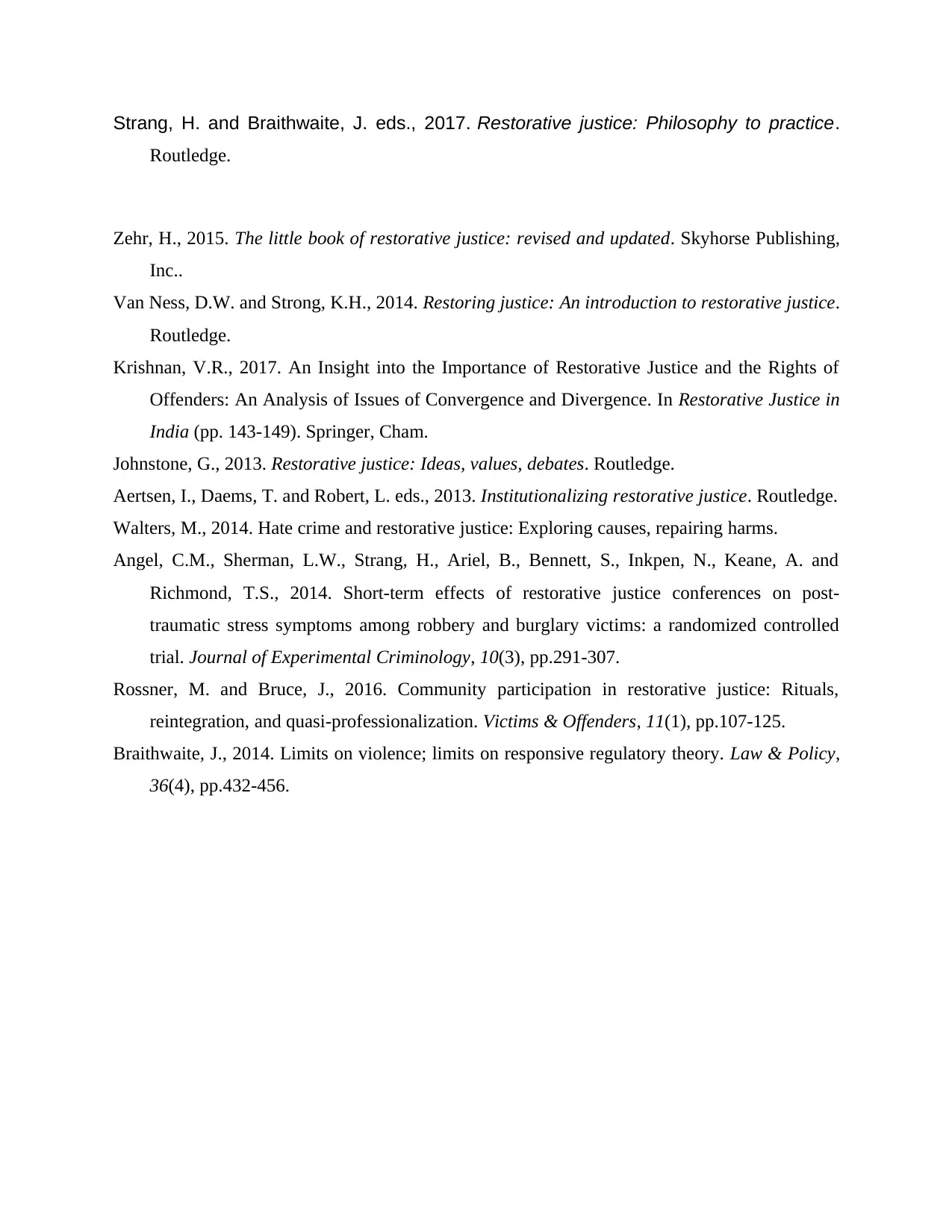
Strang, H. and Braithwaite, J. eds., 2017. Restorative justice: Philosophy to practice.
Routledge.
Zehr, H., 2015. The little book of restorative justice: revised and updated. Skyhorse Publishing,
Inc..
Van Ness, D.W. and Strong, K.H., 2014. Restoring justice: An introduction to restorative justice.
Routledge.
Krishnan, V.R., 2017. An Insight into the Importance of Restorative Justice and the Rights of
Offenders: An Analysis of Issues of Convergence and Divergence. In Restorative Justice in
India (pp. 143-149). Springer, Cham.
Johnstone, G., 2013. Restorative justice: Ideas, values, debates. Routledge.
Aertsen, I., Daems, T. and Robert, L. eds., 2013. Institutionalizing restorative justice. Routledge.
Walters, M., 2014. Hate crime and restorative justice: Exploring causes, repairing harms.
Angel, C.M., Sherman, L.W., Strang, H., Ariel, B., Bennett, S., Inkpen, N., Keane, A. and
Richmond, T.S., 2014. Short-term effects of restorative justice conferences on post-
traumatic stress symptoms among robbery and burglary victims: a randomized controlled
trial. Journal of Experimental Criminology, 10(3), pp.291-307.
Rossner, M. and Bruce, J., 2016. Community participation in restorative justice: Rituals,
reintegration, and quasi-professionalization. Victims & Offenders, 11(1), pp.107-125.
Braithwaite, J., 2014. Limits on violence; limits on responsive regulatory theory. Law & Policy,
36(4), pp.432-456.
Routledge.
Zehr, H., 2015. The little book of restorative justice: revised and updated. Skyhorse Publishing,
Inc..
Van Ness, D.W. and Strong, K.H., 2014. Restoring justice: An introduction to restorative justice.
Routledge.
Krishnan, V.R., 2017. An Insight into the Importance of Restorative Justice and the Rights of
Offenders: An Analysis of Issues of Convergence and Divergence. In Restorative Justice in
India (pp. 143-149). Springer, Cham.
Johnstone, G., 2013. Restorative justice: Ideas, values, debates. Routledge.
Aertsen, I., Daems, T. and Robert, L. eds., 2013. Institutionalizing restorative justice. Routledge.
Walters, M., 2014. Hate crime and restorative justice: Exploring causes, repairing harms.
Angel, C.M., Sherman, L.W., Strang, H., Ariel, B., Bennett, S., Inkpen, N., Keane, A. and
Richmond, T.S., 2014. Short-term effects of restorative justice conferences on post-
traumatic stress symptoms among robbery and burglary victims: a randomized controlled
trial. Journal of Experimental Criminology, 10(3), pp.291-307.
Rossner, M. and Bruce, J., 2016. Community participation in restorative justice: Rituals,
reintegration, and quasi-professionalization. Victims & Offenders, 11(1), pp.107-125.
Braithwaite, J., 2014. Limits on violence; limits on responsive regulatory theory. Law & Policy,
36(4), pp.432-456.
1 out of 15
Related Documents
Your All-in-One AI-Powered Toolkit for Academic Success.
+13062052269
info@desklib.com
Available 24*7 on WhatsApp / Email
![[object Object]](/_next/static/media/star-bottom.7253800d.svg)
Unlock your academic potential
© 2024 | Zucol Services PVT LTD | All rights reserved.




